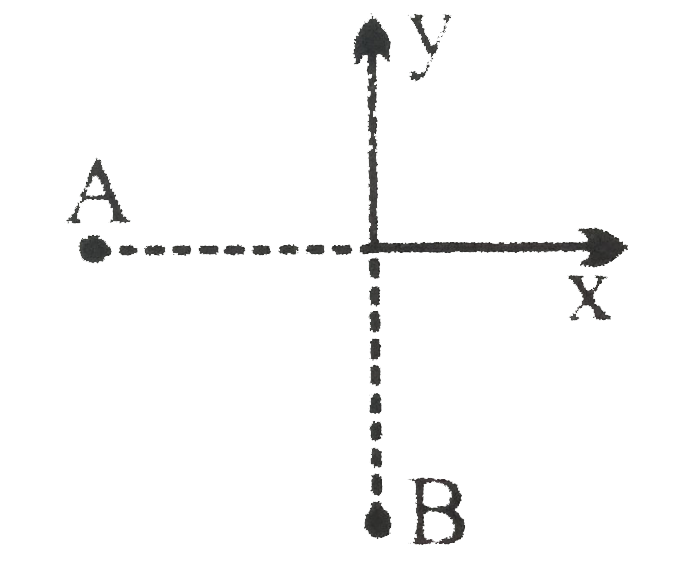Two particle are moing along X and Y axes towards the origin with constant speeds u and v respectively. At time t=0, their repective distance from the origin are x and y. The time instant at which the particles will be closest to each other is
√x2+y2√u2+v2
vx+uyu2+v2
ux+vyu2+v2
2√x2+y2u+v
The correct Answer is:C
To find the time instant at which two particles moving towards the origin along the X and Y axes will be closest to each other, we can follow these steps:
1. Understanding the Motion:
- Let particle A be moving along the X-axis with speed u and starting distance x from the origin.
- Let particle B be moving along the Y-axis with speed v and starting distance y from the origin.
2. Position of Particles Over Time:
- The position of particle A at time t will be xA(t)=x−ut.
- The position of particle B at time t will be yB(t)=y−vt.
3. Distance Between the Two Particles:
- The distance D between the two particles at time t can be expressed using the Pythagorean theorem:
D(t)=√(x−ut)2+(y−vt)2
4. Finding the Minimum Distance:
- To find the time when the distance D(t) is minimized, we can minimize D2(t) instead (since the square root function is monotonically increasing):
D2(t)=(x−ut)2+(y−vt)2
5. Differentiating with Respect to Time:
- Differentiate D2(t) with respect to t:
ddtD2(t)=2(x−ut)(−u)+2(y−vt)(−v)
- Setting the derivative to zero for minimization gives:
−2u(x−ut)−2v(y−vt)=0
- Simplifying this, we get:
u(x−ut)+v(y−vt)=0
6. Solving for Time t:
- Rearranging the equation:
ux+vy=u2t+v2t
- Factor out t:
t(u2+v2)=ux+vy
- Thus, the time t when the particles are closest is:
t=ux+vyu2+v2
Final Answer:
The time instant at which the particles will be closest to each other is:
t=ux+vyu2+v2
- Let particle A be moving along the X-axis with speed u and starting distance x from the origin.
- Let particle B be moving along the Y-axis with speed v and starting distance y from the origin.
- The position of particle A at time t will be xA(t)=x−ut.
- The position of particle B at time t will be yB(t)=y−vt.
- The distance D between the two particles at time t can be expressed using the Pythagorean theorem:
D(t)=√(x−ut)2+(y−vt)2
- To find the time when the distance D(t) is minimized, we can minimize D2(t) instead (since the square root function is monotonically increasing):
D2(t)=(x−ut)2+(y−vt)2
- Differentiate D2(t) with respect to t:
ddtD2(t)=2(x−ut)(−u)+2(y−vt)(−v)
- Setting the derivative to zero for minimization gives:
−2u(x−ut)−2v(y−vt)=0
- Simplifying this, we get:
u(x−ut)+v(y−vt)=0
- Rearranging the equation:
ux+vy=u2t+v2t
- Factor out t:
t(u2+v2)=ux+vy
- Thus, the time t when the particles are closest is:
t=ux+vyu2+v2
The time instant at which the particles will be closest to each other is:
t=ux+vyu2+v2
Topper's Solved these Questions
- TEST PAPERBOOK - ALLENCHAPTER - TEST PAPEREXERCISE - PHYSICS
4 Videos
- TEST PAPERBOOK - ALLENCHAPTER - TEST PAPEREXERCISE - PHYSICS
4 Videos
- SIMPLE HARMONIC MOTIONBOOK - ALLENCHAPTER - SIMPLE HARMONIC MOTIONEXERCISE - Example
1 Videos
- TEST PAPER 1BOOK - ALLENCHAPTER - TEST PAPER 1EXERCISE - PHYSICS
11 Videos
Similar Questions
A particle is projected with velocity v0 along x - axis. The deceleration on the particle is proportional to the square of the distance from the origin i.e. a=−x2. The distance at which particle stops is -
View SolutionParticles A and B are moving with constant velocities along x and y axis respectively, the graph of separation between them with time is

View SolutionThe acceleration of a particle is increasing linearly with time t as bt. The particle starts from the origin with an initial velocity v0. The distance travelled by the particle in time t will be
View SolutionTwo particles, A and B of masses m and 3m, are moving along X and Y axes respectively, with the same speed v. They collide at the origin, and coalesce into one body, after the c ollision. What is the velocity of this coalesced mass ?
View SolutionA simple harmonic progressive wave in a gas has a particle displacement of y=a at time t=T/4 at the orgin of the wave and a particle velocity of y =v at the same instant but at a distance x=λ/4 from the orgin where T and λ are the periodic time and wavelength of the wave respectively. then for this wave.
View SolutionA particle of mass m is moving along the line y-b with constant acceleration a. The areal velocity of the position vector of the particle at time t is (u=0)
View SolutionA particle of mass m and positive charge q is projected with a speed of v0 in y–direction in the presence of electric and magnetic field are in x–direction. Find the instant of time at which the speed of particle becomes double the initial speed.
View SolutionA particle moves with constant speed v along a circular path of radius r and completes the circle in time T. The acceleration of the particle is
View SolutionSix particles situated at the corners of a regular hexagon of side a move at a constant speed v. Each particle maintains a direction towards the particle at the next corner. Calculate the time the particles will take to meet each other.
View SolutionA particle of mass m is moving along the line y=b,z=0 with constant speed v. State whether the angular momentum of particle about origin is increasing, decreasing or constant.
View Solution
